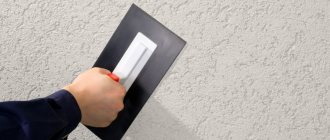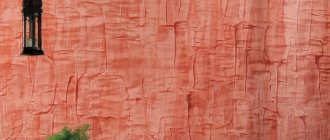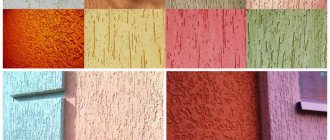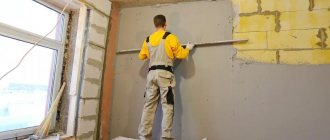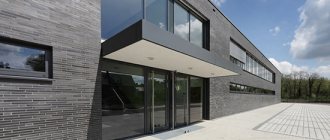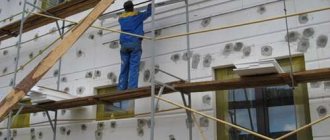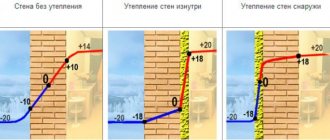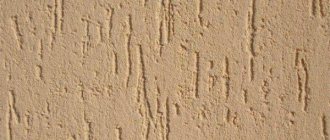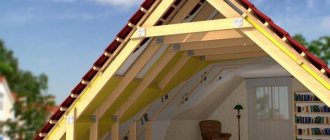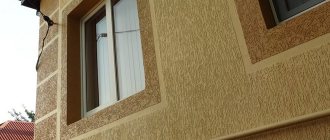Good day to all! Today I want to talk to you about how to apply special decorative bark beetle plaster with your own hands.
This material is used for interior decoration and is also used as facade plaster. It has a different composition, which depends on the manufacturer.
If you are interested, I will tell you separately and in detail about the bark beetle. Here I will add just a few words. The bark beetle has a plaster and acrylic base. Moreover, the gypsum version is sold only as a dry mixture. And acrylic is ready to use immediately.
Composition and properties of bark beetle plaster
The bark beetle can be purchased dry or prepared. Mineral or gypsum dry mixture with cement binders is diluted with water. Used indoors and outdoors. It has high hardness and a tendency to crack. Cannot be used where ground vibrations are possible (near railway tracks, in seismically unstable places).
Acrylic bark beetle mixture. Sold ready-made, high quality, elastic, with a wide color palette. Acrylic resins are characterized by increased flammability, so they contain fire retardants. Cannot be used where there is an open fire nearby.
Silicone or silicate-silicone composition is only white. The highest quality and durable plaster. One minus - expensive. Very plastic, tinted before application.
Popular manufacturers
Facade cladding is the final and important stage in the decorative finishing of a house. There are many options for plaster on the market, which differ in composition and cost. The choice of material will determine the strength, stability, service life in general and how the façade of the building will look. To select the most suitable mixture, you need to analyze the existing manufacturers on the market and the features of their products.
First of all, decorative plaster “Bark beetle” is in demand and is in demand from such manufacturers as Ceresit and Murexin. Facade material Ceresit (cezerite) is a product of the German association Henkel. It is distinguished by the fact that it is quite well known in the building materials market and is popular in Russia, and, accordingly, the choice of this plaster is large.
Bolars facade plaster is produced using the latest German equipment. The product is especially in demand on the dry mix market and has been produced for quite a long time (since 1999), therefore it has all the necessary quality certificates.
The next manufacturer under consideration will be Knauf. It also has an extensive range of facade plaster; these products, in turn, are popular everywhere. Knauf appeared back in 1932 and acquired serious knowledge, skills and experience that are used to this day, which undoubtedly affects the quality features of the product.
Bolix plaster is a Polish product and is famous in our country. Bolix has a large selection of shades, textures and reliefs.
Caparol plaster is produced in Germany and is known in Europe and on the world market in general. Caparol products meet all standards.
The unusual facade plaster TIM 26 (“Technologies and Materials”) is produced in Russia, characterized by frost resistance and such advantages as elasticity, moisture resistance, and strength. Plaster is optimal for decorative finishing of houses in cold areas. TIM 26 specializes in the production of dry mixes.
“Lamb” facade plaster has a different pattern, since the mixture has grains of different sizes. The main developers are Baumit, Ferozit and Knauf. The construction market also presents Stone Flower “Amethyst” plaster; the facades of houses with such cladding acquire the effect of amethyst stone. The main manufacturer is CementTorg.
The Russian company “Starateli” has been creating the plaster of the same name since 1992; due to its experience, the plaster stands out for its high quality and reasonable cost.
Texture of bark beetle plaster
On the surface plastered using the “Bark Beetle” method there are small depressions, similar to the surface of a tree eaten away by a bark beetle. This voluminous texture looks very unusual in one or two colors. It is created using a special composition and application of material.
The ready-made or dry mixture includes marble chips of fraction 1 – 3.5 mm. The larger the pebbles, the larger and deeper the bark beetle’s furrows become. Their shape and direction depend on rubbing.
It is possible to form the following textures:
- Rain (straight or diagonal). To create direct rain, strictly vertical movements are made with a plastic trowel - a grater intended for rubbing; for diagonal rain - diagonally.
- Carpet: by alternating vertical and horizontal movements with a trowel. The furrows are arranged in blurred squares, similar to the weave of a carpet.
- The “Lamb” pattern is obtained by making circular, arched movements with a grater.
- A surface with the texture of balsa wood is obtained by rubbing it with a foam trowel using rotating, circular strokes of the hand.
The secret of the appearance of the drawing
At first glance, it may seem that creating such a pattern is a very difficult and time-consuming task, not to mention compositions that provide a repeating pattern.
In fact, everything is much simpler; the secret is to add granules and mineral fillers of different sizes to the composition.
The larger the mineral chips, the clearer the pattern. It is absolutely not necessary to follow the rule of using a large pattern on the facade and a small one for interior decoration; you can use it the other way around or even combine it, it all depends only on the designer’s imagination.
Bark beetle base
The basis for bark beetle plaster can be different: cement, brick, gypsum wall finishing. Many people insulate their houses with polystyrene foam, which is covered with a layer of putty under the plaster.
A reinforcing mesh should be installed over the foam plastic underneath the bark beetle.
- One rule is useful: if you are planning significant work on finishing the house (foam insulation, putty, plaster), you need to think through everything as carefully as possible in advance, use materials of the same brand.
- This is also provided for by the companies themselves, which produce products that combine well with each other. It is also important to immediately decide on the style and color of the finish, so that you do not have to putty, replaster, and one color does not break through another.
On large areas of finishing, especially in bright lighting inside or outside the building, errors and miscalculations are very noticeable.
Areas of use
Bark beetle plaster was originally used to decorate the external walls of buildings. But designers have successfully found use for it in the interior.
Plasticity and obedience to the master’s tool are distinctive features that make it possible to apply plaster on a base of varying complexity and any type - concrete, cement, brick, wood, plasterboard, glass and many others.
Indoors, Bark Beetle plaster is more often used in the interior of bathrooms and toilets, due to its ability to retain its structure for a long time and its properties in a humid environment.
When choosing plaster, it is advisable to take into account the dominant component in the composition. For example, a water-based, odorless material is suitable for residential premises.
Primer before applying bark beetle plaster
The primer used is the same brand as the plaster. It is important to immediately determine which mixture will be used. The main importance is its appearance and quality: for internal or external work; composition of the plaster, coarse-grained or fine-grained (the appearance and pattern depend on this); color.
You can choose products of a certain brand, but the brand, in this case, does not matter much. Unless it will cost more than similar, equally high-quality mixtures from other manufacturers.
- Experts recommend priming surfaces with strengthening compounds containing quartz sand.
- Penetrating deep into the surface of the base, these liquids greatly increase the adhesion and water resistance of the coating.
- Such protection, increasing the strength of the base material, will prevent moisture penetration, peeling, peeling of layers, and prevent the development of mold.
There are solid bases for plaster and dust-forming ones. It is enough to treat hard ones with a primer once, but you will have to go over dust-forming ones twice. The weather must be warm, dry.
You can quickly prime with a roller or a wide brush. The primer must dry well. This will take up to 6 hours. If the walls are concrete or covered with cement-sand plaster, they do not need to be primed, but should be thoroughly wetted with water an hour before applying the Bark Beetle.
Advantages and disadvantages
Finishing with bark beetle has positive and negative sides. You can objectively decide whether to choose this material for home design by studying all the nuances of the issue. Among the advantages are the following:
- Environmental resistance. The bulk of plaster mixtures are created to be resistant to ultraviolet exposure, moisture resistant, resistant to changes in temperature, and mechanical shocks;
- Harmless to humans. The components do not contain toxic elements, which allows them to be used for finishing any premises without fear. You don’t have to use personal protective equipment when working, and it doesn’t emit a pungent odor;
- Durability, the composition is strong and reliable, most mixtures will last up to 15 years, there are also some wear-resistant options that last for more than a dozen years;
- Applying the solution is simple, distribution occurs without complications. And the preparatory stages do not require getting rid of the smallest defects on the base; getting the desired pattern is also not difficult;
- Ease of care. After drying, the coating can be washed; if necessary, you can paint over a stubborn stain. When you get tired of the design color, you can repaint the surface differently;
- Reasonable cost, the most affordable option is mineral-based. Those based on silicate and acrylic are more expensive, but their durability and stability are worth the extra expense.
Among the disadvantages are the following:
- The coating is resistant to mechanical loads. However, if a spall occurs, it is difficult to carry out restoration work on the area. The problem is the difficulty of obtaining the same pattern during correction;
- Novice craftsmen note the difficulty of painting the surface due to the relief of the base. Painting all the indentations may seem like a daunting task and the process takes longer.
The composition is durable and reliable, most mixtures will last up to 15 years.
Preparation of the solution
After this, you can prepare the mixture for plastering. The finished product usually has a homogeneous mass, but the composition includes marble chips. Pebbles, even if they are the smallest, tend to sink to the bottom, so the finished mixture also needs to be mixed well, using a drill with an attachment.
The nozzle must be immersed deep into the bucket so that the mixture does not draw in air bubbles. Stir slowly, gently scrolling along the entire bottom of the container.
- The finished plaster and the dry mortar prepared from it must be worked as quickly as possible.
- Dilute the dry mixture a little at a time, only for one batch.
- Subsequently, adding water to the finished or diluted mixture is strictly prohibited.
It is important to understand this well and not try to revive a solution that has been standing for some time in order to save money. Otherwise, time will be wasted, and the appearance of the facade will be hopelessly damaged.
Design of houses with bark beetle on the facade
“Bark beetle” plaster on the facade, created on a base of acrylic binder, is notable for the fact that it makes it possible to make the appearance of the building bright and unique. Today, in the design of facades, preference is given to warm colors. Facades decorated in yellow, red, brown and beige shades look nice.
You can incorporate multiple colors into your home's exterior design. One-story and two-story houses look especially presentable with “Bark Beetle” facade plaster. “Bark beetle” goes well with the stone finishing of the base, with forged elements, stairs and columns. The “bark beetle” looks harmonious with elements made of natural stone or wood.
Application of bark beetle
Bark beetle should be applied in dry, warm weather. You should try to choose a day or time that is not very hot, because rapid drying will interfere with work, and cracks may also form.
Simply stir the finished mixture, carefully pour the dry mixture into water, mix well with a drill and mixer, let stand for 5 to 10 minutes, stir again and apply in a thin layer. Remove excess liquid solution from the wall into another container. Their reuse is impossible due to the lack of crumbs.
- An equal, even layer is created with a 300 mm metal trowel.
- Excessive amount of plaster is collected with a trowel and a 100 mm wide spatula.
- The thickness of the layer depends on the size of the marble chips in the mixture.
- This is approximately 1-3.5 mm. After application, allow to dry for about 20 minutes.
- The plaster should not shine or stick; then, by rubbing, a pattern is created.
Although the finished coating takes 30-40 minutes. seems dry, for complete readiness it should take at least a day before painting.
Types and benefits
The possibilities for finishing houses at this time are very large. Some of them are expensive, while others are cheaper. Therefore, when choosing which is better, drywall or plaster, you need to understand that each option has its own advantages and disadvantages, original decorative characteristics and various technical features.
For more information about the technology of applying decorative plaster “Bark beetle”, watch the video:
As for the construction of private houses, one of the most popular finishing options is “Bark Beetle”.
Plaster Bark beetle
“Bark beetle” plaster is generally divided in its composition into acrylic and gypsum plaster. The main difference between different types of plaster is the form in which they are sold.
Acrylic is sold in its ready-to-apply form . Gypsum is sold in the form of dry mixtures, which will need to be diluted during construction, making it ready for application to the wall. This link will tell you about plastering aerated concrete walls indoors.
In general, the plaster itself is a composite mixture that contains small granular stones that contribute to the formation of a special pattern, which is the most distinctive feature of this material. Find out about the proportions of cement-lime mortar for plastering walls here.
Gypsum based plaster
The granules differ in size and structure depending on the manufacturer of the plaster. For them, either small marble elements or mineral chips are used. The grain size of the material is determined by the size of the granules, which can be from 0.1 to 3.5 mm.
The plaster itself is characterized by many qualities, including a significant number of positive ones:
- ease;
- environmental friendliness;
- fire resistance;
- durability;
- tolerance to exposure to precipitation;
- resistance to mild mechanical stress;
- possibility of coloring;
- ubiquity;
- affordable price.
When choosing materials for wall decoration, their weight plays an important role. In this regard, “Bark Beetle” is suitable for most surfaces, due to the fact that instead of heavy sand, mineral fillers or polymers are used in its composition.
The components of decorative plaster do not have any adverse effects on the environment, including humans.
The temperature resistance thresholds of the “Bark Beetle” are very wide, as it can withstand severe frosts down to -55 degrees Celsius and high heat up to +60 degrees Celsius.
At the same time, the material does not fade when exposed to direct sunlight and does not emit harmful substances when exposed to fire. The “bark beetle” can be wiped and lightly cleaned using weak chemical solutions.
The main color of plaster is white, but it can be painted using various types of dyes in any other color that the owner of the building desires. This type of wall covering is sold in almost all construction stores around the country, so there are no difficulties in purchasing it.
The affordable price for a large number of people contributes to the popularity of the material and its widespread use. This article will tell you about warm plaster for interior work.
Painting bark beetle plaster
Initially, it is recommended to tint the primer to match the tone of the plaster, which will create a more saturated color; areas with a thin layer, which still appear, will not show through, even with very careful application of the external finishing coat.
You can add dye to the finished acrylic or silicone mixture. It is necessary to dose out the amount very carefully, and also rub it well so that there are no lumps or clots of paint left.
- It is not recommended to tint dry mixtures when mixing. You need to paint already dried plaster with special facade paints no less than 24 hours after application.
- The first layer is applied with a wide brush or long-haired roller. To obtain a beautiful two-color bark beetle, the top layer is carefully painted over with a velor roller with very short pile, which is slightly dipped in paint so as not to paint over the furrows.
- Carefully done painting of the bark beetle looks excellent. The painted surface must be allowed to dry and covered with 1-2 layers of varnish.
“Bark beetle” plaster is light; protects well from cold and noise; easy to apply; hides surface defects; durable; resistant to fungi; washes well; environmentally friendly, does not fade under the sun.
Difficulty can arise from color selection and repairs in case of damage. Compared to the numerous advantages, this is a small drawback that does not affect the popularity of a beautiful and practical material.
Using plaster on foam plastic.
To apply bark beetle plaster to polystyrene foam, you need to stock up on the following construction attributes:
- Bark beetle
- Reinforcing mesh and glue.
- Primer paint.
Bark beetle plaster is often used for exterior decoration of buildings. Foam plastic is usually used to insulate objects, so you need to know about all the nuances of applying bark beetle to this insulation.
Important! If the bark beetle is applied to foam plastic in the standard way, then as a result the coating will be deformed and the plaster will begin to crumble.
First, you need to apply reinforcing glue and mesh to the foam. In order for the coating to dry, it is enough to wait a day. Next, you can apply primer paint, which will provide good adhesion to the foam and prevent the layer from “sliding.”
Before application, the bark beetle must have the recommended consistency. If the choice fell on an unfinished mixture, then after preparing it you can begin the work process.
Important! Any facade work associated with surface treatment with plaster must be carried out at above-zero temperatures.
Photo of ideal wall finishing with bark beetle plaster
What work does surface preparation include?
Before making bark beetle, it is necessary to thoroughly prepare the base for work. They begin by cleaning the surface of all types of contaminants; the old finish, which will worsen the reliability of adhesion, is also removed. If there are large dents, they are covered with cement mortar. If there are large cracks, they expand and are filled with mortar, and also secured with reinforcing mesh. The base is primed, the composition is used with quartz sand in the composition intended for this material.
When a significant difference in the wall is detected, plastering work is carried out using beacons; the usual type of plaster is used. If required, thermal insulation is carried out; after installation, the selected insulation is covered with reinforcing mesh. The mesh is secured with cement plaster. A special type of two-layer primer is applied.
This also includes preparing a bark beetle solution. The dry mixture is prepared according to the manufacturer's recommendations. Proportions are strictly observed.
When a significant difference in the wall is detected, plastering work is carried out using beacons; the usual type of plaster is used.
